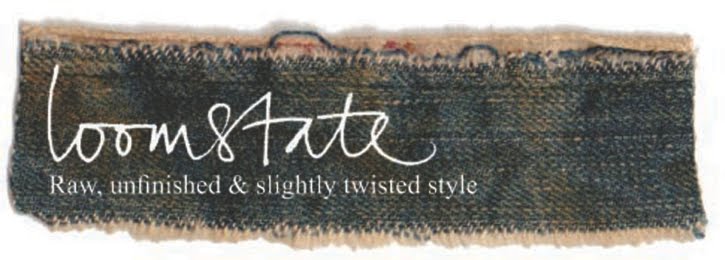I wouldn't have been quite so overjoyed had I know that the new fabric would be the last developed and loomed at the historic White Oak plant in Greensboro. Words fail me on that subject right now, so instead here's photo gallery from my trip to the indigo fields, plus a Q&A with Allen Little, who designed that wonderful fabric, used for last season's LVC 1880s repro of a pair of jeans in the Levi's archives named Stumpy.
Tell me about how you developed the new
natural indigo fabric.
It was a group development like a lot
of our LVC. They typically have a theme, we meet with Paul [O'Neill] and his
team to get the flavour. This particular one, was a little different.
The 1880s jeans predate the 501, so it is earlier than the 501
fabric. Paul and Stacia [Fink] hand-carried the jeans to me in
Greensboro and we had a meet. It’s an unusuall pair of jeans that
they call it Stumpy! We laid it out...and looked at the fabric. When
they show us something like we can’t [destroy part of] it. We have
to look closely, and also go though out own collection of old fabrics
so we understand it. From a construciton standpoint we try and go
back in time and understand what level of technology existed or did
not exist, from the construction, there’s all sort of character
caused by problems with lack of technology So we created some yarns
to mimic the fabric. This one has a lot of different qualities,
there’s the lack of process control, character details, nepping As
far as the natural indigo part, we had a source [Linda Bellos] who we
met a long time ago … we were happy with the results and it made
sense to do it in natural indigo, produced in the USA so here we are
again a lot of years later with .
How long did it take to work out?
It took about two months for this fabric.
How long did it take to work out?
It took about two months for this fabric.
Does using natural indigo change the
dyeing process?
We apply it the same way, the concentration of natural tends to be lower so we have to compenstate for that. But from years to year we evaluate the propertyies, the plants grow some years better than others.. so for us it’s a matter of binding the crop and keeping it [consistent].
How does the natural indigo vary?
We apply it the same way, the concentration of natural tends to be lower so we have to compenstate for that. But from years to year we evaluate the propertyies, the plants grow some years better than others.. so for us it’s a matter of binding the crop and keeping it [consistent].
How does the natural indigo vary?
We want to make sure we have the whole
crop represented. The very first vegetables are typcially young and
tender, then less and less so as the season goes . To make sure we
don’t have a problem with the dyeing size [there is] proper
blending and mixing of the early to the mid to the last harverst.
And we have procedures where we are checking the storage and we have
procedures for seeing it gets mixed early and doesn’t settle. All
thing we don’t have to do with the synthetic.
The natural indigo jeans I’ve worn
often look different... but in general the dye seems to sink further
into the yarn, is there a reason for that?
I think your basic assumption is
correct. Any producer can create an effect, let’s say they don’t
like it to penetrate, so you have it chip off easily [like with] some
of the Japanese jeans, where it’s on the very surface of the yarn.
We have a dyeing methodology [that’s different from] that. But if
you do something different along the way, in dyeing or preparation,
there are all sorts of things that affect it; how tight the yearns
are, temperatures, the acidity of the dye. For natural indigo I
think, at least for us, we want to dye it just like it was when
natural indigo was used. There was no tweaking of any of the
chemistry involved in the dyeing. But [even without tweaking,
natural] indigo does wash down different.
I’m full of admiration for this
project, which goes right back down to the very beginnings of Levi’s
and Cone.
It’s been very exciting. It’s plant-based so it’s much more sustainable and that’s very important for us. It’s part of our heritage... the first ]Cone] fabric was a shuttle fabric. It has its own look for sure, it is a little redder than some but it truly doesn’t look like anything we’ve dyed before. For me.. as a development person, this is the best project you could ever give me, it’s so iconic.
It’s been very exciting. It’s plant-based so it’s much more sustainable and that’s very important for us. It’s part of our heritage... the first ]Cone] fabric was a shuttle fabric. It has its own look for sure, it is a little redder than some but it truly doesn’t look like anything we’ve dyed before. For me.. as a development person, this is the best project you could ever give me, it’s so iconic.

















